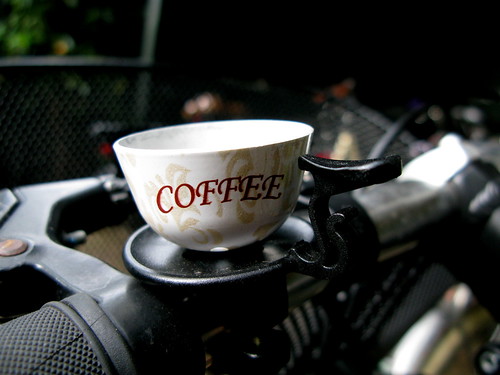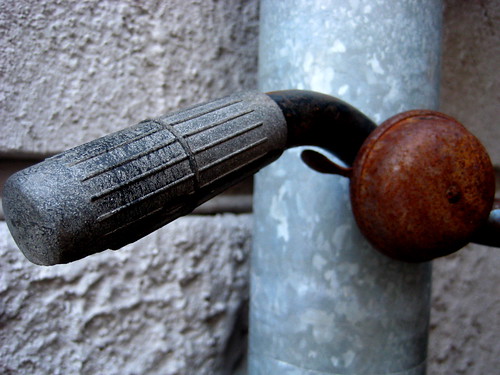

One of our readers, Bob Allen, offered us this lovely article for publication here on Copenhagenize.com. It was originally published over at Sustainable Times but it fits perfectly in here. Thanks, Bob. On an editorial note, the bicycle bell is required by law in Denmark.
Bicycling For the Rest of Us - Ring That Bell! by Bob Allen.
There was no pleasing the boss at a bicycle shop I worked for years ago. I could sell one of the most expensive bicycles in the place and come off the sales floor to be greeted by a scowl.Selling a bicycle, even an expensive one, was never enough. You had failed unless you also made sure the bicycle rolled out of the shop bristling with accessories. “Sell bells!” the shop owner would exhort.Accessories offer a much better profit margin than bicycles. Bicycles don’t have much markup. After paying shipping costs and investing significant time to properly assemble and adjust a machine, financing overhead expenses and the time spent finding a buyer for the thing, it’s a wonder many bicycle shops can keep their doors open.Many could not survive without the profit generated by their service departments and accessory sales. And herein lies a conundrum.Bicycling is inherently simple. All you really need is a bicycle. You don’t need fancy add-ons. You don’t need special clothing. All you need is a bicycle and the will to make it move.In providing a dazzling array of doodads, the bicycle industry is indeed creating potential profits for local bicycle shops. But it also is making a simple thing seem more complicated than it needs to be. Does this discourage potential riders? I suspect that anything that makes riding a bicycle seem more out of the ordinary than it already is perceived to be might be counterproductive. If, for example, people feel they need to get fully kitted out in the latest bicycling attire before venturing out, how many actually venture out? How many fewer bicycles get sold if people think buying a bicycle means equipping an entire new lifestyle? Without question, high tech clothing designed specifically for bicycling can help a serious or competitive rider go faster and farther in greater comfort. But for the rest of us, everyday clothing works just fine. Civilian clothes are better, in fact, if you are riding someplace where you will end up mingling with non-riders. There’s just something about wandering around in clickity shoes and bright tight Spandex that makes one stand out in a crowd.There are many useful things that can be added to the basic bicycle. Baskets, racks and bags make it possible to bring home the groceries or carry an extra layer of clothes for changes in weather. Fenders or mudguards can keep a rider caught in the rain a bit more comfortable while keeping debris off the bicycle. Lights can stretch riding time and are especially useful given the short daylight hours of a Wisconsin winter. A good lock is advisable for any bicycle left exposed to the criminal elements. A few basic tools can help keep you going out on the road.And bells, ah bells. The old bicycle shop owner was right on this one. But it’s not about ringing cash register bells. A good bell is a civilizing addition to any bicycle. Not necessary, but nice.None of these add-ons is necessary for traveling around on a bicycle. I just took a perfectly comfortable 20-mile ride with temperatures in the high 30s wearing the kind of plain old clothes that allowed me to blend right into the crowd of bluegrass fans at my destination.If you have a good coat, or enough layers, and some good gloves or mittens, a warm scarf – essentially what you need to get through a Wisconsin winter anyway – you have all the clothing you need to ride a bicycle in the winter. Summer, of course, is easy. Ride as you are.Rejection of bicycling-specific clothing is a first step toward reining in the “otherness” of bicycle riders. This simple stance rises to high fashion at the fabulous Danish web site www.copenhagencyclechic.com. The site’s curators have the curious belief that the everyday act of riding a bicycle doesn’t require you to look like a space alien. In fact, they chronicle example after example of ordinary people looking quite marvelous while riding bicycles.Copenhagen, of course, is a city where bicycles are more ingrained in the culture than here in the upper Middle West. Bicycles seem to move freely throughout Copenhagen without many of the dreary little controversies that stalk two-wheelers here.Many of these stateside controversies seem to be stoked by an “us versus them” mentality -- drivers versus bicyclists -- bicyclists versus pedestrians. When “us and them” blend, it’s much harder to point fingers. Of course, it’s not so simple. Some of the finger pointing, even the middle finger, can seem well deserved if you are the offended party. Some drivers subject riders to needless danger through inattention or malicious intent. These road hogs don’t understand that bicycle riders have an equal right to the road. Likewise, too many bicycle riders don’t realize that along with that right guaranteed by law comes an obligation to follow that law.And even well intended and otherwise polite riders sometimes seem oblivious to how the simple act of breezing by a pedestrian on a trail can startle the heck of the unsuspecting biped.And here is where the simple bell saves the day. A bell allows a rider to announce his or her approach in a gracious, non-threatening way. A nice bell gives the kind of cheery warning to a pedestrian that is almost always appreciated. I have a beautiful little brass bell on my three-speed that sustains its note for seven seconds. It could double as a call to meditation. I’ve even had people complement me on the sweet tone of this bell.Contrast such warmth and appreciation with the reaction of somebody who has just been startled by a bicycle silently swooshing by at speed. The startled pedestrian probably doesn’t feel very warmly toward bicycle riders at that moment.Communication works wonders, and it is not limited to rider-walker interactions. It is also a common courtesy, though often overlooked, for a faster rider to alert a slower rider who is being overtaken. A bell isn’t necessary for communicating with pedestrians or other riders. A simple announcement of “passing on your left” will do. But there’s something about a bell that makes the interaction sound more pleasant and less like a declaration of dominance.Communication is not just common courtesy. It’s the basis of safe riding in traffic of any kind. While a little bell won’t help a rider in dealing with motorists, clear hand signals and riding in a predictable straight line – in other words not making the motorist guess -- will make sharing the road much more pleasant for all involved.A simple bell will not change the world and make lions lie down with lambs. But the courtesy of using a bell -- or hand signals, or the directional signals in your motor vehicle -- surely can’t hurt. It’s a start.Bob Allen has been riding, working on and advocating bicycles for a long time. He lives in Middleton.
For more bicycle bell photos, have a look at my Flickr photostream here.





